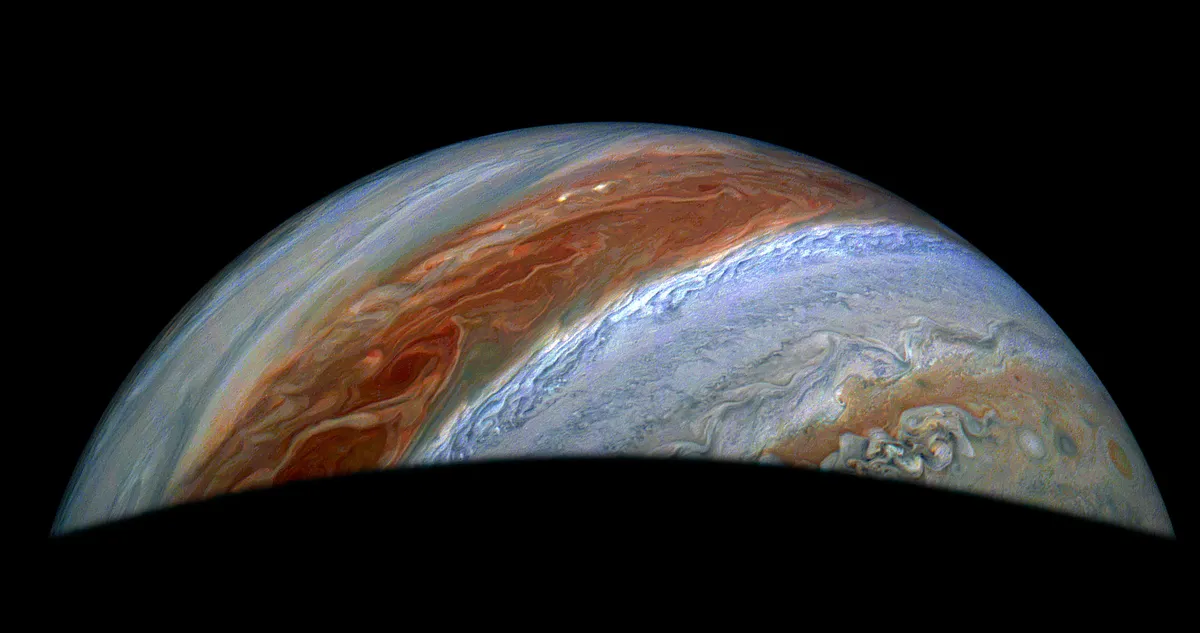
A flurry of new discoveries from NASA's Juno mission has taken us beneath the surface of the gas giant's volcanic moon, Io, and revealed extraordinary phenomena at the northern pole of Jupiter. Since its arrival in the Jupiter system in 2016, Juno has been providing invaluable insights into the planet and its moons, even as a failed thruster has left it in a wide, polar orbit that allows close encounters every 53 days.
During its flybys, Juno has gathered a treasure trove of high-quality data about Jupiter's atmosphere, particularly at the planet's poles, which had not been studied in detail before. At Jupiter's north pole, Juno discovered a cap of stratospheric haze that is remarkably cooler than its surrounding areas, measuring a chilling 52 degrees Fahrenheit (or 11 degrees Celsius). This polar cap is encircled by jet streams that blow at speeds exceeding 100 miles per hour (approximately 161 kilometers per hour).
Delving deeper into the atmosphere, the north polar region features a massive central cyclone measuring about 1,864 miles (or 3,000 kilometers) across. This central cyclone is surrounded by eight smaller cyclones, each ranging from 1,490 to 1,790 miles (approximately 2,400 to 2,800 kilometers), dwarfing any similar weather systems found on Earth. Juno has been meticulously tracking the motion of these cyclones in both visible and infrared light since 2016, utilizing its JunoCam and Jovian Infrared Aurora Mapper (JIRAM).
These observations have revealed that the cyclones drift towards the pole through a process known as beta drift, similar to the behavior of cyclones on Earth. However, unlike their terrestrial counterparts, Jupiter's cyclones can survive and thrive near the poles due to different atmospheric dynamics. As they approach the pole, the cyclones start to interact, bouncing off one another like springs in a mechanical system. This interaction stabilizes the entire cyclone configuration and causes them to oscillate around their central positions while they drift westward in a clockwise motion.
Meanwhile, Juno has also been making significant discoveries about Io, the most volcanic body in our solar system. During a flyby on December 27, 2024, Juno observed what is now considered the most energetic volcanic eruption ever recorded on Io. The volcano was still actively erupting during a subsequent flyby on March 2, and it is anticipated to remain active for Juno's next flyby on May 6, when it will pass within 55,300 miles (about 89,000 kilometers) of Io's surface.
What has particularly excited the Juno science team is the data revealing what lies beneath Io's surface. By integrating the spacecraft's Microwave Radiometer (MWR) with JIRAM, scientists managed to measure underground temperatures, uncovering evidence of subterranean magma flows. According to Shannon Brown from NASA’s Jet Propulsion Laboratory, combining different datasets from various instruments allows researchers to gain deeper insights into planetary processes.
Upon analyzing the MWR data alongside JIRAM's infrared imagery, scientists discovered indications of warm magma that has yet to solidify beneath Io's cooling crust. These findings suggested that at every latitude and longitude on Io, there are cooling lava flows. While Juno previously ruled out the presence of a large magma ocean beneath the surface, these cooling, rising magma flows could explain the moon's frequent volcanic activity. The science team estimates that approximately 10% of Io's subsurface is occupied by these cooling flows, shedding light on how heat is transported from the moon's hot interior to its surface, allowing for the persistent resurfacing through lava flows.
As Brown noted, Io's volcanoes and lava fields act like a car radiator, efficiently transferring heat from the interior to the surface while cooling down in the vacuum of space. The latest findings from Juno were presented at the European Geosciences Union General Assembly in Vienna on April 29, marking a significant milestone in our understanding of both Jupiter and its intriguing moon Io.